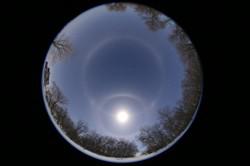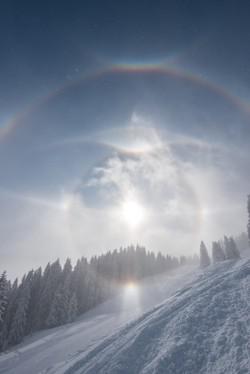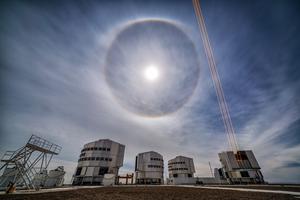Glossarbegriffe: Halo
Description: Ein Halo ist ein optisches Phänomen, das durch Eiskristalle in der Erdatmosphäre verursacht wird. So wie die Brechung und Reflexion von Licht an Wassertropfen Regenbögen verursacht, wird Licht, das Eiskristalle durchläuft, in den Eiskristallen reflektiert und gebrochen. Halos können viele verschiedene Formen annehmen und durch Sonnenlicht oder Mondlicht erzeugt werden. Der 22-Grad-Halo (oder 22-Grad-Ring) ist ein kreisförmiger Halo, der sich als dünnes Lichtband um die Sonne oder den Mond bildet. Die Geometrie dieses Halos liegt an der Kristallstruktur der Eiskristalle, die das Sonnen- oder das Mondlicht in der Atmosphäre durchlaufen.
Der Begriff "Halo" wird auch in anderen astronomischen Zusammenhängen verwendet, z. B. im Zusammenhang mit dem galaktischen Halo, dem Halo der Dunklen Materie und dem stellaren Halo, die alle wichtige Komponenten der Struktur von Galaxien sind.
Zugehörige Glossarbegriffe:
See this term in other languages
Term and definition status: The original definition of this term in English have been approved by a research astronomer and a teacher The translation of this term and its definition is still awaiting approval
The OAE Multilingual Glossary is a project of the IAU Office of Astronomy for Education (OAE) in collaboration with the IAU Office of Astronomy Outreach (OAO). The terms and definitions were chosen, written and reviewed by a collective effort from the OAE, the OAE Centers and Nodes, the OAE National Astronomy Education Coordinators (NAECs) and other volunteers. You can find a full list of credits here. All glossary terms and their definitions are released under a Creative Commons CC BY-4.0 license and should be credited to "IAU OAE".
If you notice a factual or translation error in this glossary term or definition then please get in touch.
Zugehörige Medien
Selene meets the Moon, by Sheila Wiwchar, Canada
Bildnachweis: Sheila Wiwchar/IAU OAE
License: CC-BY-4.0 Creative Commons Namensnennung 4.0 International (CC BY 4.0) icons
Winter Haloes, by Thomas Gigl, Germany
Bildnachweis: Thomas Gigl/IAU OAE
License: CC-BY-4.0 Creative Commons Namensnennung 4.0 International (CC BY 4.0) icons
ESO's Very Large Telescope (VLT) at Paranal Observatory with a lunar halo
Bildnachweis: Juan Carlos Muñoz-Mateos/ESO credit link
License: CC-BY-4.0 Creative Commons Namensnennung 4.0 International (CC BY 4.0) icons
Lunar rainbow and lunar Brocken spectre, by Kouji Ohnishi, Japan
Bildnachweis: Kouji Ohnishi/IAU OAE
License: CC-BY-4.0 Creative Commons Namensnennung 4.0 International (CC BY 4.0) icons












